Home
Hungary
Cardinal József Mindszenty
1956 Hungarian Revolution (My Story)
(My Eyewitness story of our Freedomfight
and Resistance against the Soviet Invasion)
50th Anniversary of our Freedomfight
My Travel and Photos Pages
Africa
America - North
America - Central
America - South
Asia
Australia
Oceania
My China pages directory
Beijing or Peking
Beijing Buses
Beijing - Forbidden City
Beijing - Prince Gong Palace
Beijing - Summer Palace
Great Wall of China
Guangzhou or Canton
Guangzhou Buses
Guangzhou trains
Hong Kong
Hong Kong Airport
Hong Kong Buses
Hong Kong - Lantau Island
Kashgar or Kashi
Kashgar Buses
Kashgar Sunday Market
Macau
Ming Dynasty Tombs
Peking Man's Caves/Zhoukoudian
Shanghai
Shanghai Buses
Shanghai Maglev / Transrapid
Shanghai Metro
Shenzhen
Shenzhen Buses
Tibet
Tibet - Lhasa
Tibet - Lhasa Monasteries
Tibet - Lhasa - Potala
Turpan or Tulufan
Turpan - Amin Mosque
Turpan - Astana Graves
Turpan - Bezeklik Caves
Turpan - Crescent Moon Lake
Turpan - Dunhuang Caves
Turpan - Echoing-Sand Mountain
Turpan - Ediqut Ruins
Turpan - Emin Minaret
Turpan - Flaming Mountains
Turpan - Gaochang Ruins
Turpan - Grape Valley
Turpan - Green Mosque
Turpan - Jesus Sutras
Turpan - Jiaohe Ruins
Turpan - Karez System
Turpan - Maza Village
Turpan - Mogao Caves
Urumchi or Urumuchi
Xian
Xian Buses
Xian - Hua Qing Pool
Xian - Silk Factory
Xian - Silk Road Monuments
Xian - Terracotta Factory
Xian - Terracotta Army Museum
Yanan
Yanan Buses
Yanan Cave Dwellings
|

China facts & history in brief
 My China pages directory
My China pages directory
Map of China
Mogao Caves
Excerpted from Wikipedia, the free encyclopedia
The Mogao Caves, or Mogao Grottoes (also known as
the Caves of the Thousand Buddhas and Dunhuang Caves) form a
system of 492 temples 25km (15.5 miles) Southeast from the
center of Dunhuang, an oasis strategically located at a
religious and culture crossroads on the Silk Road, in
Gansu province, China on the edges of the Taklamakan Desert.
The caves contain some of the finest examples of Buddhist art
spanning a period of 1,000 years.
Construction of the Buddhist cave shrines began in 366 CE
as places to store scriptures and art.
The Mogao Caves are the most well known of the Chinese
Buddhist grottoes and, along with Longmen Grottoes and
Yungang Grottoes, are one of the three famous
ancient sculptural sites of China.
According to local legend, in 366 CE a Buddhist monk
had a vision of a thousand Buddhas and inspired
excavation of the caves he envisioned.
The number of temples eventually grew
to more than a thousand.
As Buddhist monks valued austerity in life, they sought
retreat in remote caves to further
their quest for enlightenment.
From the 4th until the 14th century, Buddhist monks
at Dunhuang collected scriptures from the west while
many pilgrims passing through the area painted
murals inside the caves.
The cave paintings and architecture served as aids to
meditation, as visual representations of the quest
for enlightenment, as mnemonic devices, and as
teaching tools to inform illiterate Chinese about
Buddhist beliefs and stories.
The murals cover 450,000 square feet (42,000 mē).
The caves were walled off sometime after the 11th
century after they had become a repository for venerable,
damaged and used manuscripts and hallowed paraphernalia.
The following has been suggested:
" The most probable reason for such a huge accumulation of
waste is that, when the printing of books became widespread
in the tenth century, the handwritten manuscripts of the
Tripitaka at the monastic libraries must have been
replaced by books of a new type - the printed Tripitaka.
Consequently, the discarded manuscripts found their way
to the sacred waste-pile, where torn scrolls from old
times as well as a bulk of manuscripts
in Tibetan had been stored.
All we can say for certain is that he came from the
Wu family, because the compound of the three-storied
cave temples, Nos. 16-18 and 365-6, is known to have
been built and kept by the Wu family, of which the
mid-ninth century Bishop of Tun-Huan,
Hung-pien, was a member. "
- Fujieda Akira, "The Tun-Huan Manuscripts"
The Mogao manuscript trove forms the backdrop of the
plotline of the Japanese movie The Silk Road (1988,
English subtitles), adapted from a 1959 novel by Yasushi Inoue.
One of the stories from the caves were adapted into
a Chinese animation in 1981 titled a A Deer of Nine Colors.
Barbara Wright mentions the Mogao Caves in
the Doctor Who serial Marco Polo.

For a more information about
Mogao Caves see Wikipedia, the free encyclopedia

This page was retrieved and condensed from
(http://en.wikipedia.org/wiki/Mogao_Caves)
see Wikipedia, the free encyclopedia, November 2007.
All text is available under the terms of the
GNU Free Documentation License
(see
Copyrights for details).
About Wikipedia
Disclaimers

This information was correct in November 2007. E. & O.E.

Hui Chin and I joined a conducted bus tour
from Urumchi to visit Turpan.
It was a very interesting trip and full of drama, as
there was many interesting places to visit and there
was also a number of arguments
on the bus about the tickets and
sights to be visited, the sitting arrangements on the
bus and also about the food and the quality and hygene
standard of the restaurants we have visited.
To cap it all of, my camera's battery ran flat, half
way through, our spare battery and another camera sitting
safely back at the hotel in Urumchi (laughing at our
misfortune), but a few weeks later I had even worst news,
when, after returning home, I found out that two of my
new 2Gigabyte SD memory cards, although seemed to work
perfectly at the time, have invisible pictures on them.
The pictures seem to exist alright,
with all around the 200 plus kilobyte
properties and showing as jpeg pictures, but can't be viewed.
I have lost some very interesting, unusual and irreplacable
pictures of Turpan, Urumchi, Bishkek in Kyrgizstan and pictures
of the countrysides of Kyrgizstan and Kazakstan.
____________o______O_______o____________
Now altough we were there and had our visual and phisical
experiences, I have to take advantage of using Wikipedia,
the free encyclopedia's
resources with our greatful thanks. Author.
____________o______O_______o____________
I would like to mention a few things, that was mentioned to us
during our visit to Turpan, but I do not find any mention on
the pages and articles I read before
putting this page together.
Turpan is sited in a basin (Turfan Depression),
at the second deepest hole after the Dead Sea - under
sea level.
(328ft. below sea level).
Turpan is one of the hottest place on earth, due to its
desert location and relative altitude.
Turpan also one of the driest place on earth again due
to it's location and altitude. (This last two points
make it ideal place to grow grapes and other fruit with
the Karez (water) System's help.
Some of Turpan's listed attractions may be 40+ kilometres
away, normally they still will be listed
as Turpan's attraction.
On the way to Turpan from Urumchi our bus stopped at a
fortress, as I lost the many photos I have taken of this
place - as I have explained above, now I can't find any
reference or mention of the place -
can somebody help me, please? Author.

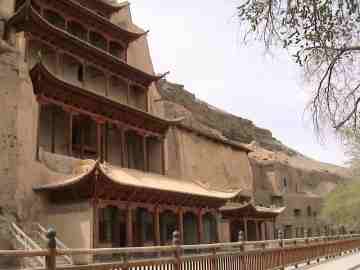
Mogao Caves or Mogao Grottoes
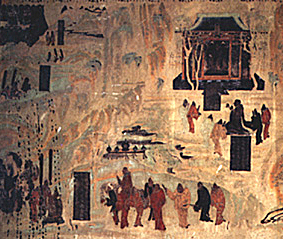
Mogao Caves - A complete view of the painting

Mogao Caves - Zhang Qian
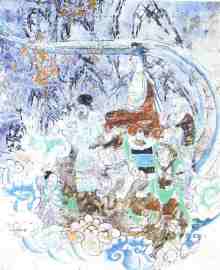
Xuanzang ceremonies for the Buddha
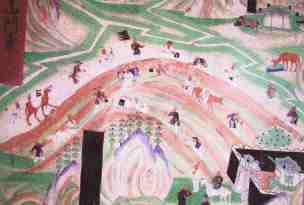
Mogao Caves - Silk Road
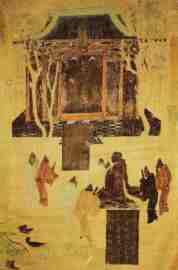
Mogao Caves - Part of the wall painting

|